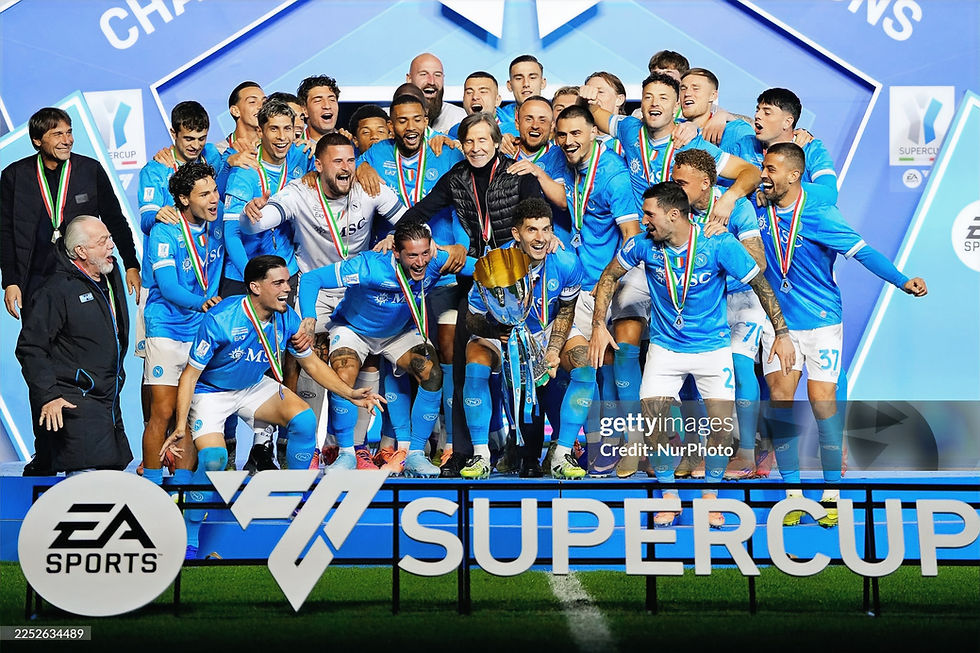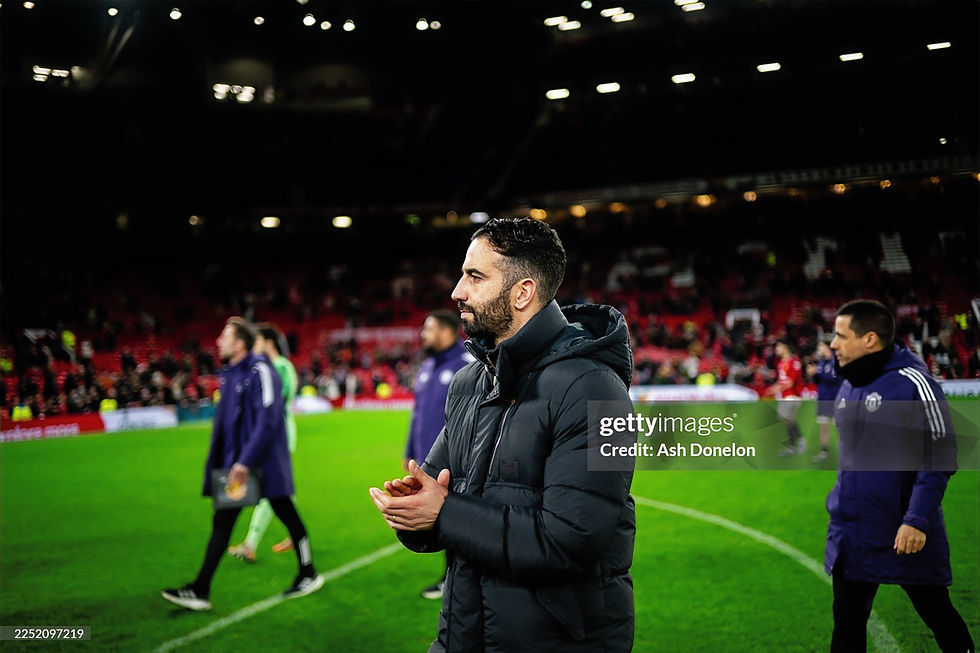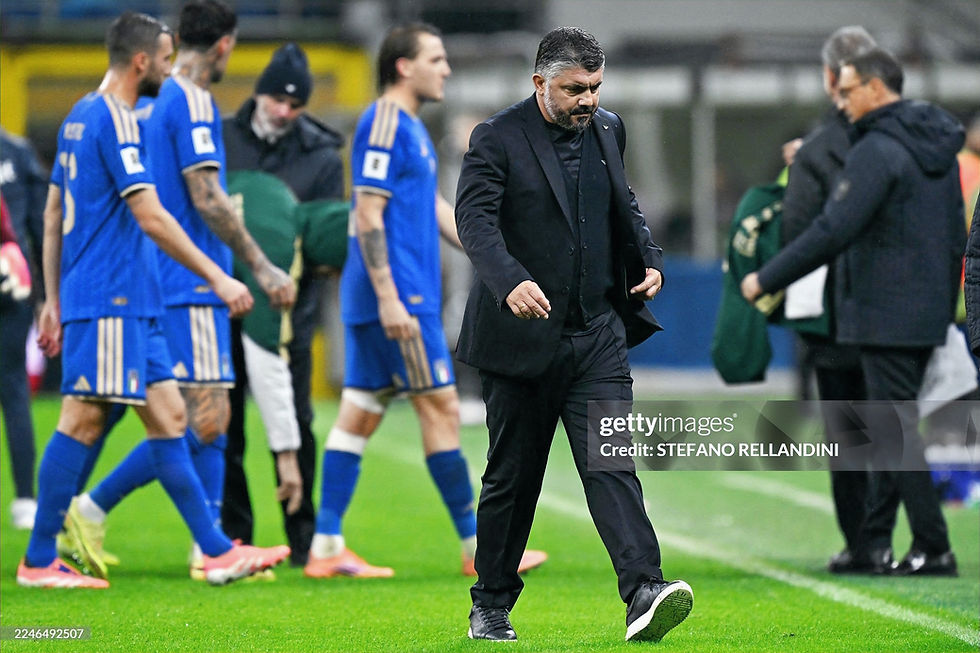Allegri's Milan: The Before, The During & The In-between
- Christian Paris
- Jul 17, 2025
- 6 min read

Massimiliano Allegri’s return to AC Milan after 11 years signals the moment to take a well-judged view at the contrasting success the two have had since they parted ways in 2014.
It has been a turbulent period to say the least for the Rossoneri, particularly following on from Allegri’s departure in the middle of the 2013/14 season, in which just five wins from the first 19 Serie A fixtures saw the Italian dismissed.
What ended up being a difficult ending to his time in Northern Italy overshadowed what was generally a successful period for a club that had struggled for the most part in the 2000s to get a hold of the Scudetto.
The Rossoneri won the Italian title just once in the decade when they clinched the Scudetto in 03/04 season under Carlo Ancelotti, the season which preceded the infamous Calciopoli scandal.
Milan in fact were one of the five Italian clubs to face sanctions after allegations emerged of bribing match officials and senior league members, and were ultimately given an eight-point deduction for the 04/05 campaign, that was followed by a much heftier 30-point deduction the subsequent season.
It certainly did not help their remainder of the decade, and whilst sanctions saw Milan and famously Juventus struggle to recover, city rivals Inter Milan took advantage, winning the next five Scudetto titles under a mix of Roberto Mancini and Jose Mourinho.

Before Allegri’s arrival Milan were scrambling to get back to the top of Italian football. The Rossoneri had won the UEFA Champions League in 06/07 though finished fourth in Serie A, a frightening 36 points adrift of Inter.
That squad still featured world class stars. The likes of Dida, Alessandro Nesta and Paolo Maldini defensively, Andrea Pirlo, Gennaro Gattuso and Clarence Seedorf in midfield, poacher extraordinaire ‘Pippo’ Inzaghi up top, not to mention Ballon D’Or winning superstar Ricardo Kaká.
It was meanwhile an ageing side, most of the names mentioned were well into their 30s, and the following seasons saw the result of that, finishing in the then UEFA Cup places the next campaign, before successive third-placed finishes to end the decade.
In stepped Allegri.
2010 - 2014: From Glory to Struggle
Inter were well on top in Italy at the time and had just come off a historic treble-winning season under Mourinho, who subsequently departed for Real Madrid in the summer of 2010, and their immediate struggles under Rafa Benitez opened the door for Milan.
Allegri had just been dismissed late in the 09/10 season at Cagliari after an impressive spell in Sardinia, and the timing was just right to replace Leonardo who had only been in the job for that season.
The Italian manager came into a squad with a real blend of youth and experience, though it wasn’t without the additions of Robinho from Manchester City and most notably the arrival of Zlatan Ibrahimovic on loan from Barcelona, who was well in his peak years.
The Rossoneri still had their decorated veterans in Nesta and Inzaghi, Seedorf, Gattuso and Pirlo still at the heart of midfield whilst Allegri utilised the legs of Kevin-Prince Boateng, and the frightening talents of Alexandre Pato.
It had all fallen into place for Allegri and co, edging out their city rivals and ending their dominance in Italy, whilst simultaneously winning their first Scudetto since 2004.

And though one era of dominance ended in Italy, another began. Antonio Conte’s arrival in Turin spearheaded an unprecedented period of superiority for Juventus and immediately put Allegri’s Milan on the back foot once again, despite being champions.
That Juventus side was ultimately just too good for the rest of Serie A from 2011-14. The Bianconeri edged out Milan, going invincible in 11/12, whilst Allegri was facing a testing challenge to refresh a squad in need of reinforcements.
Pirlo had departed ironically for Juventus after winning the Scudetto at the San Siro in 2011, Allegri had to oversee a complete midfield revamp with Seedorf leaving the club in January of 2012 after ten seasons with the Rossoneri, whilst Gattuso left in that summer.
It was ultimately the beginning of the end for Allegri at Milan, the incomings of Nigel de Jong and Riccardo Montolivo were going to struggle to replicate the midfield quality of the previous decade.
Ibrahimovic and Thiago Silva both left for PSG ahead of Allegri's third season, Nesta likewise though at the end of his career. Finishing third that campaign was not disastrous by any means, but they had slipped further behind Juventus, where a four-point deficit from the season prior had become 15.
It preceded a difficult start to 13/14, where Juventus’ dominance looked unbreachable, Milan dropped further and further away. Struggling to replicate any sort of consistency from his time at the San Siro, Mister Allegri was sacked in January, whilst the Rossoneri ended up eighth.
2014 - Present Day: The 11 Years In Between
Contrasting fortunes after parting ways has made their rekindling even more intriguing. Allegri pounced on the opportunity to join the Juventus juggernaut after Conte left, re-establishing their supremacy at the top of Italian football, whilst adding greater success in Europe.
Conte hadn’t managed to make it past the Quarter-Finals in his three seasons in Turin, whereas Allegri stepped in and immediately led the Bianconeri to a first Champions League final in 12 years.
Reunited with veteran Pirlo, which was short-lived however when the Italian left at the end of Allegri’s first season, though the Mister still had a superb midfield with the likes of Claudio Marchisio, a young Paul Pogba, and Arturo Vidal.

Despite defeat in the final to Barcelona, Allegri looked to have broken Juventus’ struggle in Europe, where they had looked unbeatable in Serie A, success continentally was imperative for the Italian giant.
Another final beckoned just two seasons later, a slightly different iteration of Allegri’s Juve, this time including the likes of Paulo Dybala, Mario Mandzukic and Gonzalo Higuain leading from the front, this time against a potent Cristiano Ronaldo led Real Madrid who were in search of successive European titles.
Allegri’s side lost out once more, another heartbreak on the European stage, though the Italian had the Bianconeri back in the upper echelons of the elite, competing consistently, Milan meanwhile, the opposite happened.
Failure to even qualify for the Champions League for seven consecutive seasons was complete failure for a club so enriched in European prestige, the last time followed Allegri’s final full campaign at the San Siro.
It was a damning contrast. Where one party went up, the other declined. Allegri certainly played a part in the beginning of a dire period for Milan, though ownership issues, a desperate recruitment strategy, and a lack of participation in the Champions League saw one of the world’s greatest clubs lose relevance.
Milan had to wait until almost a decade later to finish inside the top four in Serie A, finishing runners-up to a fantastic Inter side under Conte in 2021, though promise of a return to the summit was brewing.
That Inter side had broken Juventus’ monopoly in Italy at last. Nine successive Scudetto titles had left both Milan sides stumbling to catch up, whilst they did so capitalising on Juventus’ drop in standards, where the Bianconeri finished fourth, Inter took the first chance, before Milan did the same.
In 21/22, Juve’s fall from the summit was re-established with another fourth-place finish, whilst Inter and Milan battled it out for the Scudetto. The Rossoneri got their own back on their city rivals from the previous season, pipping Inter to the title by just two points.

Milan had finally done it again. In another twist to the Allegri/Milan tale, it had swung the other way, at least briefly for Milan that is, whilst Allegri’s return to Juve that season signalled a tougher challenge to overcome for the Bianconeri.
Once their superiority was broken it never returned and hasn’t to this day. Allegri left Turin in 2019 clinching another Scudetto on his way out before then, though returning two seasons later aiming to restore Juventus’ position at the peak of the mountain.
It wasn’t to be this time for Mister Max, who couldn’t overcome the strength of the top sides in Italy who had caught up. Milan, Inter and Napoli all won the Scudetto during his second stint, and despite a Coppa Italia triumph in May 2024, his emotional outburst that followed saw La Vecchia Signora dismiss Allegri, finally culminating a historic relationship.
The ending of that partnership meanwhile sparked the renewal of another. Milan had struggled to sustain their position after their triumph in 2022 despite consecutive years in Europe, and laboured to eighth last season, where Sergio Conceição’s time as boss was short-lived.
It was time to reunite. Allegri and Milan. Where he once returned the Rossoneri to Scudetto glory, he has rejoined the club with a steeper task. Allegri meanwhile returns a greater manager, with all the experience and success in between, can Mister Max fire Milan back to the top?





Comments